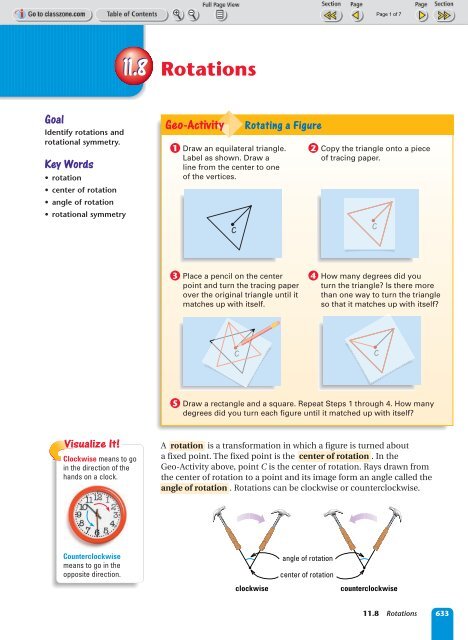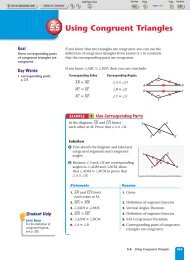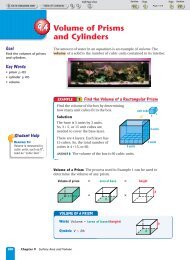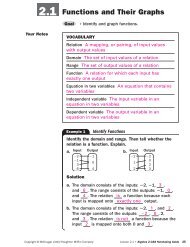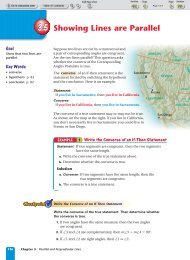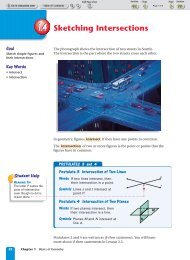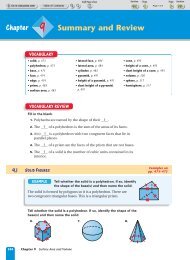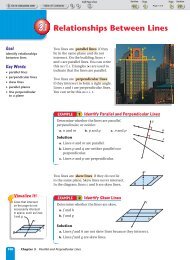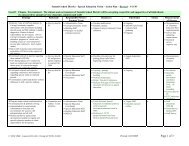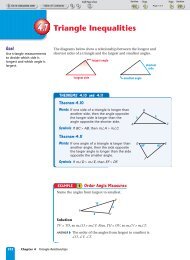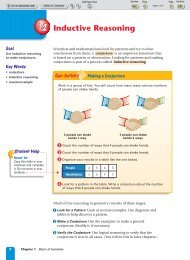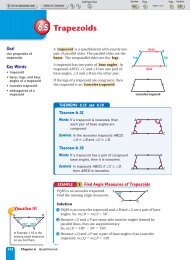11.8 Rotations
11.8 Rotations
11.8 Rotations
You also want an ePaper? Increase the reach of your titles
YUMPU automatically turns print PDFs into web optimized ePapers that Google loves.
Goal<br />
Identify rotations and<br />
rotational symmetry.<br />
Key Words<br />
• rotation<br />
• center of rotation<br />
• angle of rotation<br />
• rotational symmetry<br />
Visualize It!<br />
Clockwise means to go<br />
in the direction of the<br />
hands on a clock.<br />
Counterclockwise<br />
means to go in the<br />
opposite direction.<br />
<strong>11.8</strong> <strong>Rotations</strong><br />
Geo-Activity<br />
Rotating a Figure<br />
●1 Draw an equilateral triangle. ●2 Copy the triangle onto a piece<br />
Label as shown. Draw a of tracing paper.<br />
line from the center to one<br />
of the vertices.<br />
C<br />
●3 Place a pencil on the center ●4 How many degrees did you<br />
point and turn the tracing paper turn the triangle? Is there more<br />
over the original triangle until it than one way to turn the triangle<br />
matches up with itself. so that it matches up with itself?<br />
C<br />
●5 Draw a rectangle and a square. Repeat Steps 1 through 4. How many<br />
degrees did you turn each figure until it matched up with itself?<br />
A rotation is a transformation in which a figure is turned about<br />
a fixed point. The fixed point is the center of rotation . In the<br />
Geo-Activity above, point C is the center of rotation. Rays drawn from<br />
the center of rotation to a point and its image form an angle called the<br />
angle of rotation . <strong>Rotations</strong> can be clockwise or counterclockwise.<br />
angle of rotation<br />
center of rotation<br />
clockwise counterclockwise<br />
C<br />
C<br />
<strong>11.8</strong> <strong>Rotations</strong> 633
634 Chapter 11 Circles<br />
Rotational Symmetry A figure in a plane has rotational symmetry if<br />
the figure can be mapped onto itself by a rotation of 180 or less. For<br />
instance, the figure below has rotational symmetry because it maps<br />
onto itself by a rotation of 90.<br />
0<br />
EXAMPLE 1 Identify Rotational Symmetry<br />
Does the figure have rotational symmetry? If so, describe the rotations<br />
that map the figure onto itself.<br />
a. Rectangle b. Regular hexagon c. Trapezoid<br />
Solution<br />
a. Yes. A rectangle can be mapped onto itself by a clockwise or<br />
counterclockwise rotation of 180 about its center.<br />
0<br />
b. Yes. A regular hexagon can be mapped onto itself by a clockwise or<br />
counterclockwise rotation of 60, 120, or 180 about its center.<br />
0<br />
60<br />
180<br />
120<br />
c. No. A trapezoid does not have rotational symmetry.<br />
Identify Rotational Symmetry<br />
30 60<br />
180<br />
Does the figure have rotational symmetry? If so, describe the<br />
rotations that map the figure onto itself.<br />
1. Isosceles trapezoid 2. Parallelogram 3. Regular octagon<br />
90
IStudent Help<br />
I CLASSZONE.COM<br />
MORE EXAMPLES<br />
More examples at<br />
classzone.com<br />
EXAMPLE 2 <strong>Rotations</strong><br />
Rotate T FGH 50 counterclockwise<br />
about point C.<br />
Solution<br />
●1 To find the image of point F,<br />
draw CF&* and draw a 50 angle.<br />
Find Fso that CF CF.<br />
●2 To find the image of point G,<br />
draw CG&* and draw a 50 angle.<br />
Find G so that CG CG.<br />
●3 To find the image of point H,<br />
draw CH&* and draw a 50 angle.<br />
Find H so that CH CH. Draw<br />
T FGH.<br />
EXAMPLE 3 <strong>Rotations</strong> in a Coordinate Plane<br />
Sketch the quadrilateral with vertices A(2, 2), B(4, 1), C(5, 1), and<br />
D(5, 1). Rotate it 90 counterclockwise about the origin and name<br />
the coordinates of the new vertices.<br />
Solution<br />
Plot the points, as shown in blue.<br />
Use a protractor and a ruler to find the<br />
rotated vertices.<br />
The coordinates of the vertices of the<br />
image are A(2, 2), B(1, 4), C(1, 5),<br />
and D(1, 5).<br />
<strong>Rotations</strong> in a Coordinate Plane<br />
C<br />
C<br />
C<br />
C<br />
G<br />
C<br />
B<br />
G<br />
F<br />
F<br />
G<br />
1<br />
y<br />
D<br />
A<br />
A<br />
H<br />
F H<br />
F<br />
G<br />
F H<br />
G<br />
F<br />
G<br />
F H<br />
B C<br />
4. Sketch the triangle with vertices A(0, 0), B(3, 0), and C(3, 4). Rotate<br />
T ABC 90 counterclockwise about the origin. Name the<br />
coordinates of the new vertices A, B, and C.<br />
H<br />
<strong>11.8</strong> <strong>Rotations</strong> 635<br />
4<br />
D<br />
x
<strong>11.8</strong><br />
Exercises<br />
Guided Practice<br />
Vocabulary Check<br />
Practice and Applications<br />
Extra Practice<br />
See p. 696.<br />
Skill Check<br />
Homework Help<br />
Example 1: Exs. 10–15<br />
Example 2: Exs. 16–26<br />
Example 3: Exs. 27–30<br />
636 Chapter 11 Circles<br />
1. What is a center of rotation?<br />
2. Explain how you know if a figure has rotational symmetry.<br />
Does the figure have rotational symmetry? If so, describe the<br />
rotations that map the figure onto itself.<br />
3. 4. 5.<br />
The diagonals of the regular hexagon shown form six equilateral<br />
triangles. Use the diagram to complete the statement.<br />
6. A clockwise rotation of 60 about<br />
P maps R onto __?__.<br />
7. A counterclockwise rotation of 60<br />
about __?__ maps R onto Q.<br />
8. A clockwise rotation of 120 about<br />
Q maps R onto __?__.<br />
9. A counterclockwise rotation of 180<br />
about P maps V onto __?__.<br />
R S<br />
Rotational Symmetry Does the figure have rotational symmetry?<br />
If so, describe the rotations that map the figure onto itself.<br />
10. 11. 12.<br />
Wheel Hubs Describe the rotational symmetry of the wheel hub.<br />
13. 14. 15.<br />
P<br />
W<br />
P<br />
V<br />
T
Visualize It!<br />
Rotating a figure 180<br />
clockwise is the same<br />
as rotating a figure 180<br />
counterclockwise.<br />
180 counterclockwise<br />
P<br />
180 clockwise<br />
Rotating a Figure Trace the polygon and point P on paper. Use<br />
a straightedge and protractor to rotate the polygon clockwise the<br />
given number of degrees about P.<br />
16. 150 17. 135 18. 60<br />
C<br />
19. 40 20. 100 S<br />
21. 120<br />
Describing an Image State the segment or triangle<br />
that represents the image.<br />
22. 90 clockwise rotation of AB &* about P<br />
23. 90 clockwise rotation of KF &* about P<br />
24. 180 rotation of T BCJ about P<br />
25. 180 rotation of T KEF about P<br />
26. 90 counterclockwise rotation of CE &* about E<br />
Finding a Pattern Use the given information to rotate the figure<br />
about the origin. Find the coordinates of the vertices of the image<br />
and compare them with the vertices of the original figure. Describe<br />
any patterns you see.<br />
27. 90 clockwise 28. 90 counterclockwise<br />
J<br />
K<br />
29. 90 counterclockwise 30. 180<br />
A<br />
P<br />
A B<br />
D C<br />
P<br />
2<br />
3<br />
y<br />
y<br />
1<br />
1<br />
B<br />
B<br />
L<br />
A<br />
M<br />
x<br />
C<br />
x<br />
R<br />
P<br />
P<br />
S<br />
P T<br />
R T<br />
1<br />
y<br />
X<br />
1<br />
D<br />
A<br />
E<br />
W<br />
y<br />
1<br />
O<br />
1<br />
X<br />
F<br />
x<br />
Z<br />
X<br />
W Y<br />
B<br />
M<br />
H<br />
Z<br />
<strong>11.8</strong> <strong>Rotations</strong> 637<br />
C<br />
J<br />
P<br />
L<br />
G<br />
x<br />
Y<br />
P<br />
P<br />
Z<br />
D<br />
K<br />
F<br />
E
Careers<br />
GRAPHIC DESIGNERS may<br />
create symbols to represent a<br />
company or organization.<br />
These symbols often appear<br />
on packaging, stationery, and<br />
Web sites.<br />
Career Links<br />
CLASSZONE.COM<br />
Standardized Test<br />
Practice<br />
638 Chapter 11 Circles<br />
Graphic Design A music store, Ozone, is running a contest for a store<br />
logo. Two of the entries are shown. What do you notice about them?<br />
31. 32.<br />
<strong>Rotations</strong> in Art In Exercises 33–36, refer to the image below<br />
by M.C. Escher. The piece is called Circle Limit III and was<br />
completed in 1959.<br />
33. Does the piece have rotational symmetry? If so, describe the<br />
rotations that map the image onto itself.<br />
34. Would your answer to Exercise 33 change if you disregard the<br />
color of the figures? Explain your reasoning.<br />
35. Describe the center of rotation.<br />
36. Is it possible that this piece could be hung upside down and have<br />
the same appearance? Explain.<br />
37. Multiple Choice What are the coordinates of the vertices of the<br />
image of T JKL after a 90 clockwise rotation about the origin?<br />
A J(1, 2), K(4, 2), L(1, 4)<br />
B J(2, 1), K(4, 2), L(1, 4)<br />
C J(4, 2), K(2, 1), L(4, 1)<br />
D J(2, 4), K(1, 2), L(1, 4)<br />
38. Multiple Choice Which of the four polygons shown below does<br />
not have rotational symmetry?<br />
F G H J<br />
J(4, 2)<br />
2<br />
K<br />
(2, 1)<br />
1<br />
L (4, 1)<br />
y<br />
x
Quiz 3<br />
Mixed Review<br />
Algebra Skills<br />
Area of Polygons Find the area of the polygon. (Lessons 8.3, 8.5)<br />
39. rectangle ABCD 40. parallelogram EFGH 41. trapezoid JKMN<br />
B C<br />
A<br />
7 ft<br />
Evaluating Radicals Evaluate. Give the exact value if possible.<br />
If not, approximate to the nearest tenth. (Skills Review, p. 668)<br />
42. 42 43. 90 44. 256 45. 0<br />
1. What are the center and the radius of the circle whose equation<br />
is (x 1) 2 (y 6) 2 25? (Lesson 11.7)<br />
2. Write the standard equation of the circle with center (0, 4) and<br />
radius 3. (Lesson 11.7)<br />
Graph the equation. (Lesson 11.7)<br />
3. x 2 (y 1) 2 36 4. (x 2) 2 (y 5) 2 4<br />
5. (x 3) 2 (y 4) 2 9 6. (x 1) 2 (y 1) 2 16<br />
Does the figure have rotational symmetry? If so, describe the<br />
rotations that map the figure onto itself. (Lesson <strong>11.8</strong>)<br />
7. 8. 9.<br />
Use the given information to rotate the figure about the origin. Find<br />
the coordinates of the vertices of the image and compare them with<br />
the vertices of the original figure. Describe any patterns you see.<br />
(Lesson <strong>11.8</strong>)<br />
10. 180 11. 90 counterclockwise 12. 90 clockwise<br />
C(1, 3)<br />
1<br />
13 ft<br />
D<br />
y<br />
A(2, 4)<br />
B(1, 1)<br />
1<br />
x<br />
E<br />
1<br />
F G<br />
y<br />
8 cm<br />
9 cm<br />
A(1, 4)<br />
H<br />
B(4, 4)<br />
D(2, 1) C(4, 1)<br />
1<br />
x<br />
10 m<br />
K 6 m M<br />
J<br />
1<br />
y<br />
10 m<br />
1<br />
N<br />
A(2, 0)<br />
B x<br />
(4, 1)<br />
C (3, 3)<br />
<strong>11.8</strong> <strong>Rotations</strong> 639


